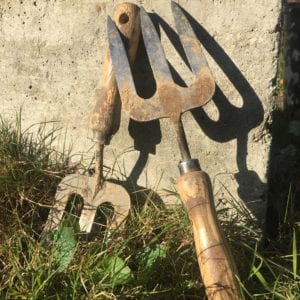By Kyrnan Harvey
In the avid gardener’s off-season, from Thanksgiving through February, if the temperatures are above 40 and the ground is not frozen, nor too waterlogged, I like to layer-up and head outside to pull up onions.
Wild onion (Allium vineale), or wild garlic, disfigures beds and lawns, more especially at the end of winter before the landscape begins to green up. The bluish-green grasslike leaves emerge in fall and remain in view all winter, the more so when our lawns lose their verdure with the cold temps and our beds are bereft of show. An old clump can be a foot tall, growing from a tight-knit congregation of a hundred bulbs.

I use a hand fork, similar to a trowel, but with three tines instead of a blade, and I am not talking about the three-tined hand cultivator. This is a tool few gardeners seem to use, or even know, but along with the steel-shafted spade and the Felco bypass secateurs is one of the indispensables. Many years ago it was easy to find forged steel ones (the defunct Smith & Hawken), in which the tines did not get bent out of alignment in tree-rooty soil. Avoid these cheap ones. There is one from Holland (DeWit Forged Hand Fork) that costs 20 bucks.
This tool is ideal for lifting out small plants — or a clump of bulbs — and teasing out the roots from the soil. Obviously, if you pull up weeds without their roots, they will surely grow back, often with increased vengeance. Nor do you want to remove too much soil with the roots, else your five-gallon bucket will get heavy real quick. And don’t dump that bucket in your compost, the bulbs won’t rot.
In the case of wild onions, you must remove from the soil the miniature onion bulbs themselves. There is another, similar, bulbous weed called star of Bethlehem (Ornithogalum umbellatum). Their leaves have a white midrib, and they lack the bluish tint — and, most obviously, the odor — of onions. Not native to North America, they have pretty flowers and an evocative common name, but they seed themselves everywhere and have become a major nuisance where once they were planted as an ornamental.
Bulbs — the lovely tulips and daffs and bluebells, as well as their weedy relatives — go dormant in summer, their leaves browning and melting into the soil. Many a time have I dug into soil to plant a shrub or perennials and have had the blade of my spade slice through daffodil or hyacinth bulbs.

If you are digging in midsummer, colonizing a frontier of the garden, you might unearth a hidden clump of wild onion, or star of Bethlehem, now dormant without leaves visible. In this case you will, in effect, be dividing a compact clump of bulbs and “splintering it into a thousand pieces.”
Later, in fall, each of these bulbs will send up their monocotyledonous leaves in a now-wider area of your planting bed. Weeds are visual noise in an otherwise harmonious garden setting, an irritant to a conscientious green thumb because experience dictates that they will only increase exponentially. A window of opportunity to remove onions and Ornithogalum and other cool-season weeds presents itself in the balmier days of the long months of winter.
To reward yourself, if you have already gotten started on this meditative chore, or to incentivize yourself if you haven’t, order 25-50 deer-proof Allium ‘Gladiator’ to plant willy-nilly in and among your established — and, er, weed-free — plantings (provided they get enough sun). More on this next time.
Kyrnan Harvey is a horticulturist and garden designer residing in East Setauket. For more information, visit www.boskygarden.com.
All photos by Kyrnan Harvey





